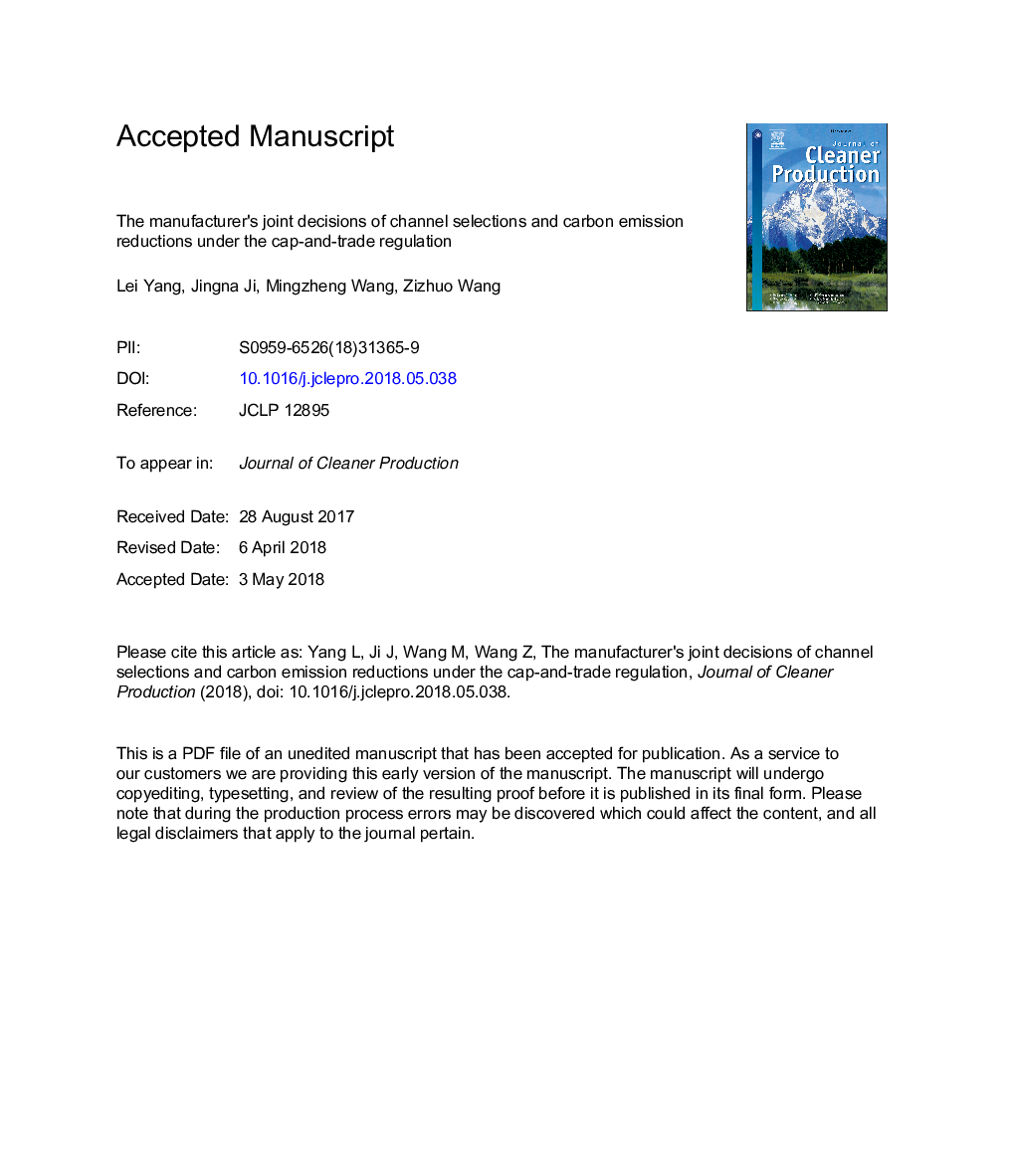| کد مقاله | کد نشریه | سال انتشار | مقاله انگلیسی | نسخه تمام متن |
|---|---|---|---|---|
| 8094544 | 1522060 | 2018 | 42 صفحه PDF | دانلود رایگان |
عنوان انگلیسی مقاله ISI
The manufacturer's joint decisions of channel selections and carbon emission reductions under the cap-and-trade regulation
ترجمه فارسی عنوان
تصمیم سازندگان تصمیم گیری کانال ها و کاهش انتشار کربن تحت مقررات کلاهبرداری و تجارت
دانلود مقاله + سفارش ترجمه
دانلود مقاله ISI انگلیسی
رایگان برای ایرانیان
کلمات کلیدی
مدیریت زنجیره تامین، انتخاب کانال، کاهش انتشار کربن، مقررات سرپوش و تجارت،
ترجمه چکیده
آلودگی محیط زیست تبدیل به یک تهدید بزرگ برای بقا و سلامت انسان شده است و توجه جهانی را جلب کرده است. با اجرای سیاست های کم کربن، چگونگی تغییر استراتژی بازاریابی یک مشکل واقعی و جدی برای شرکت ها است. در این مقاله، انتخاب کانال سازنده و تصمیم گیری در مورد کاهش انتشار گازهای گلخانه ای مورد بررسی قرار می گیرد. یک زنجیره تامین دو اکسل شامل یک تولید کننده و یک خرده فروش تحت مقررات سرپوشیده و تجارت است. با توجه به کانال های فروش آن، تولید کربن محصولات محصولات فاسد نشده و محصولات فاسد می شود. نتایج به دست آوردن بینش مفیدی برای اعضای زنجیره تامین است. اولا نتایج نشان می دهد که خواص محصولات و اولویت کانال مصرف کنندگان عوامل کلیدی برای انتخاب کانال سازنده است. هنگامی که مصرف کنندگان ترجیح می دهند خرید آنلاین را ترجیح دهند، تولید کننده، که محصولات فاسد می شود / محصولات فاقد سریع تولید می کند، باید یک کانال کانال آنلاین را انتخاب کند تا سود خود را به حداکثر برساند. اما، اگر تولید کننده محصول تولیدی فاسد شود همانطور که در کانال خرده فروشی است، این انتخاب نمی تواند به همان اندازه به محیط زیست کمک کند. ثانیا، نتایج نشان داد که در مقررات کلاهبرداری و تجارت، درگیری کانال، تا حدودی کاهش یافته است. خرده فروش می تواند کانال اضافی آنلاین را تحت شرایط خاصی قرار دهد. علاوه بر این، نتایج عددی بیشتر بینش های مربوط به دولت را نشان می دهد: برای تنظیم مقادیر کربن بزرگتر و تشویق تولیدکنندگان برای ایجاد یک حالت کانال دو کانال، زمانی که اکثر مصرف کنندگان ترجیح دادن کانال های آنلاین نیستند، موثرتر است. مصرف کنندگان بیشتر و بیشتر که ترجیح می دهند به خرید آنلاین، بتوانند کنتراست دقیق تر را منتشر کنند.
موضوعات مرتبط
مهندسی و علوم پایه
مهندسی انرژی
انرژی های تجدید پذیر، توسعه پایدار و محیط زیست
چکیده انگلیسی
Environmental pollution has become a major threat to the survival and health of human beings, and has attracted the worldwide attention. With the implementation of low-carbon policies, how to change marketing strategy is a realistic and serious problem of enterprises. This paper examines the manufacturer's channel selection and emission reduction decisions when considering carbon emission constraints. A two-echelon supply chain consisting of one manufacturer and one retailer under the cap-and-trade regulation is explored. Non-perishable products' and perishable products' carbon emissions are distinguished according to their sales channels. The results provide useful insights for supply chain members. Firstly, the results show that products' properties and consumers' channel preference are key factors affecting manufacturer's channel selection. When consumers prefer online shopping, the manufacturer, who produces perishable/non-perishable products, should choose single online channel structure to maximize his profit. But, this choice cannot make as same contributions to the environment if the manufacturer produces perishable product as that under retail channel. Secondly, the results demonstrated that under cap-and-trade regulation, the channel conflict appears to have abated somewhat. The retailer can accommodate the additional online channel under certain conditions. Additionally, numerical results further illustrate the following insights from the respective of the government: It is more effective to set larger carbon quotas and encourage the manufacturer to develop a dual-channel mode when not too many consumers prefer to online channel. With more and more consumers preferring to online shopping, it can formulate more stringent emission control.
ناشر
Database: Elsevier - ScienceDirect (ساینس دایرکت)
Journal: Journal of Cleaner Production - Volume 193, 20 August 2018, Pages 506-523
Journal: Journal of Cleaner Production - Volume 193, 20 August 2018, Pages 506-523
نویسندگان
Lei Yang, Jingna Ji, Mingzheng Wang, Zizhuo Wang,
